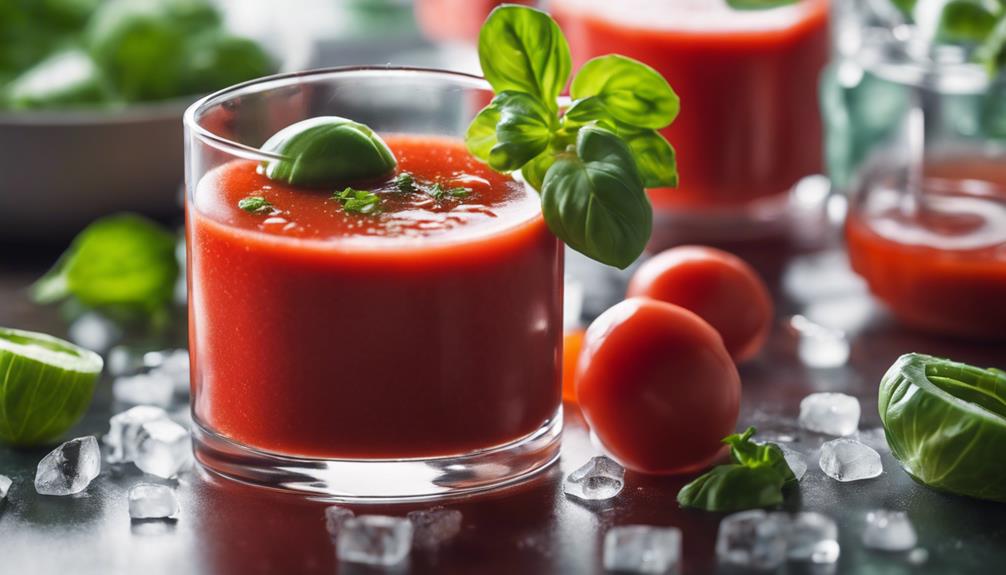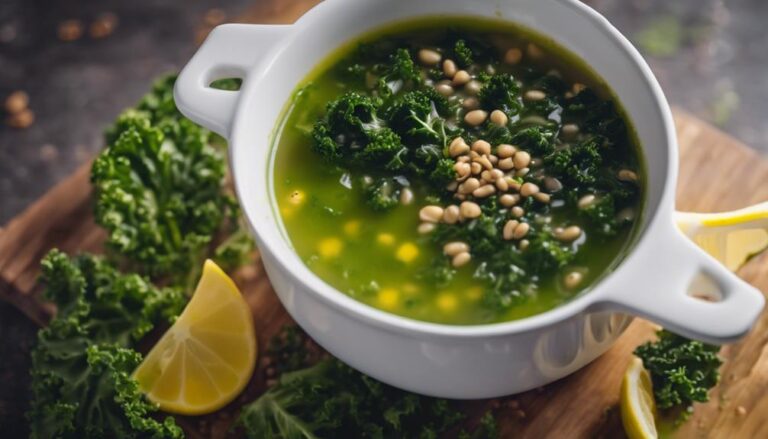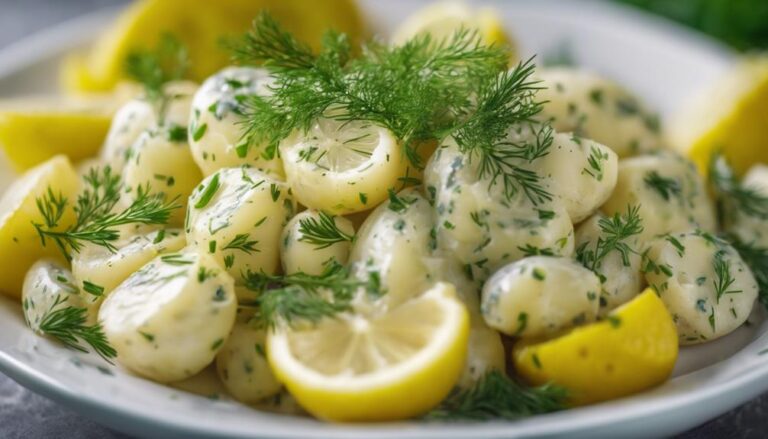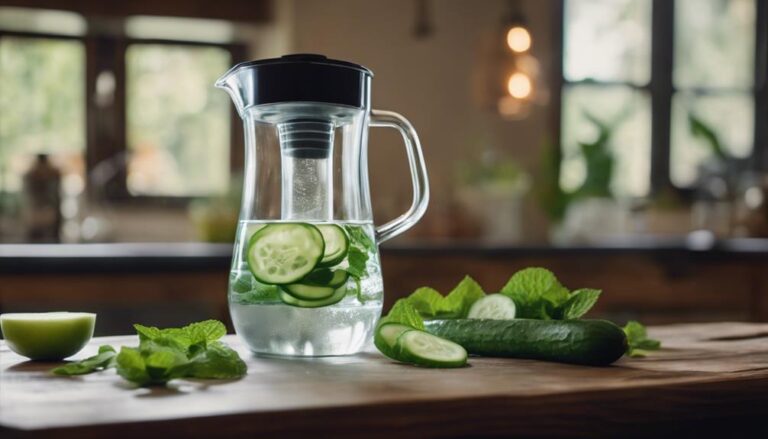Sous Vide Gazpacho: Chilled Tomato Soup
When preparing Sous Vide Gazpacho, guarantee precise temperature control for the ideal chilled tomato soup experience. The technique seamlessly blends flavors and enhances the dish's essence. Delight in the harmony of fresh ingredients and inventive cooking for a heightened taste profile.
What You Will Learn Here
- Sous Vide method enhances flavors and textures in chilled tomato soup.
- Fresh ingredients like tomatoes, cucumbers, and basil create a vibrant taste.
- Chilled serving temperature highlights refreshing qualities of gazpacho.
- Ingredients meld harmoniously over time, intensifying the flavor profile.
- Gazpacho's flexibility allows for customization in texture and meal pairings.
Origin of Gazpacho
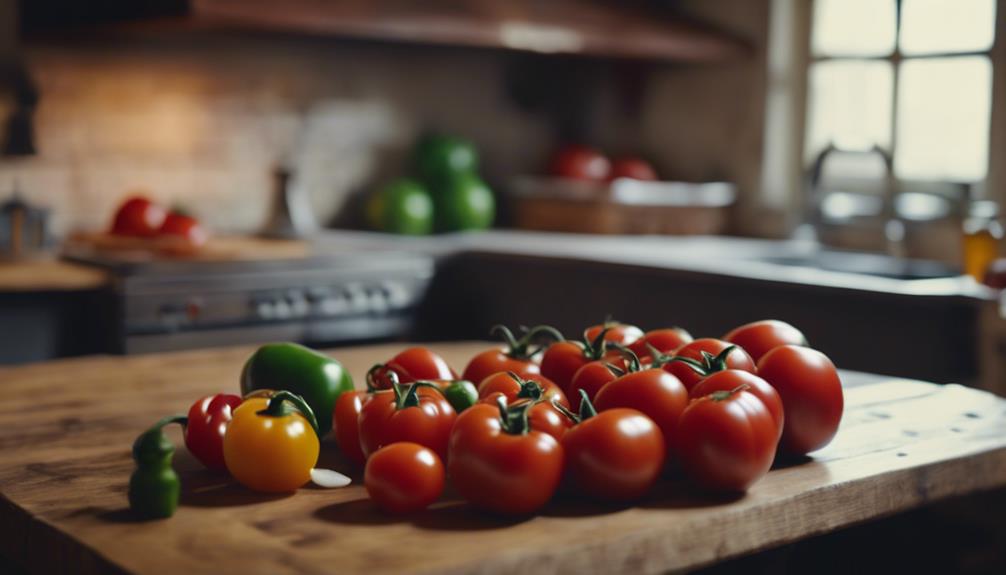
Gazpacho originated in Andalusia, Spain, as a cold soup with a base of raw ingredients.
The evolution of gazpacho has seen traditional recipes incorporating fruits and seafood alongside key ingredients like tomatoes, onion, and garlic.
Understanding the history and traditional elements of gazpacho provides insight into how this chilled soup has adapted over time.
Gazpacho Origin History
Originating in the region of Andalusia, Spain, this cold soup made with raw ingredients has a humble beginning as a peasant dish that has since evolved into modern variations. Gazpacho, a staple of Spanish cuisine, traditionally includes tomatoes, olive oil, and other raw vegetables.
The evolution of gazpacho has seen the incorporation of fruits and seafood into the traditional recipe. Originally, this dish was a simple blend of fresh ingredients, reflecting the agricultural roots of Andalusia. Over time, gazpacho has become a versatile dish, with variations in texture and flavor.
This evolution has allowed for creativity in preparation methods, with options ranging from an instant blend for a smoother consistency to a slower version using peeled tomatoes for added texture.
Traditional Gazpacho Ingredients
Traditionally, the key ingredients in authentic gazpacho from Andalusia, Spain, include a combination of fresh tomatoes, red bell peppers, red onion, cucumber, garlic, olive oil, balsamic vinegar, and spices like cumin and pepper. To prepare traditional gazpacho, these ingredients are typically blended together using a food processor until smooth.
Additionally, some variations may include basil for added vitality and flavor. The red bell peppers contribute sweetness and vibrant color, while the balsamic vinegar adds a hint of acidity to balance the flavors. The use of a food processor guarantees a consistent texture, blending all the ingredients into a cohesive soup.
These ingredients form the foundation of the classic gazpacho recipe, creating an invigorating and flavorful cold soup.
Evolution of Gazpacho
The culinary evolution of this chilled tomato soup traces back to a rustic yet innovative adaptation of traditional peasant fare. Originating in Andalusia, Spain, gazpacho started as a straightforward dish using fresh ingredients like tomatoes, onion, garlic, and cucumber. The original Spanish gazpacho emphasized the use of olive oil, sherry vinegar, and spices such as cumin and pepper to enhance its flavors.
Over time, recipes for gazpacho have evolved, incorporating a variety of additions like fruits and seafood. Today, gazpacho can be enjoyed in different forms, ranging from smooth and creamy textures to chunkier versions. The traditional yet versatile nature of gazpacho highlights its evolution from a humble peasant dish to a popular and adaptable cold soup enjoyed globally.
Tomato as the Base
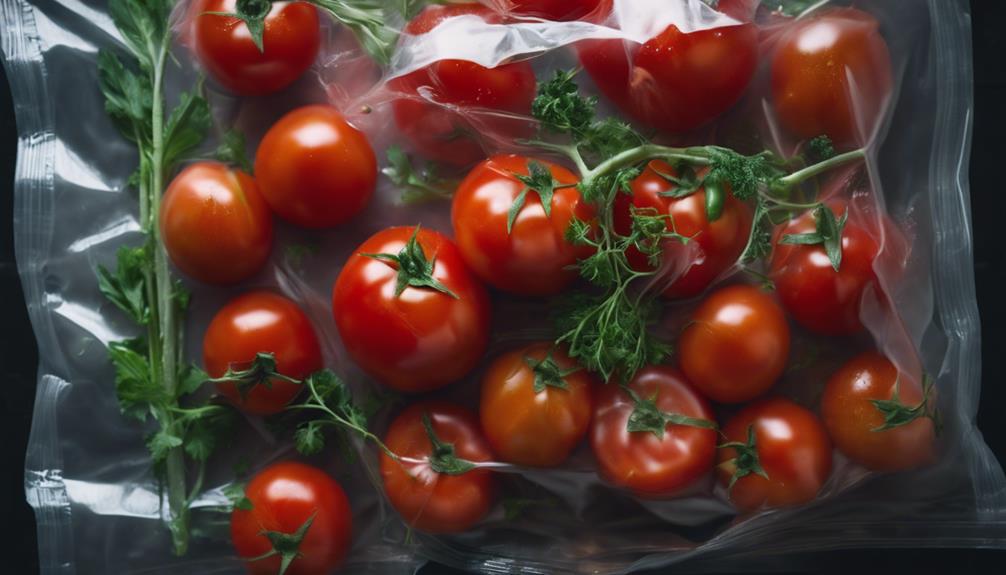
Tomato serves as the foundational element in gazpacho, anchoring the soup with its rich flavor profile and nutrient-packed composition. The chilled soup derives its essence from the following key aspects of the tomato:
- Antioxidants: Tomatoes are high in antioxidants like lycopene, offering potential health benefits by reducing the risk of certain diseases.
- Vitamins: A significant source of vitamins A, C, and K, tomatoes contribute to the nutritional value of gazpacho.
- Acidity: The tangy acidity of tomatoes provides a revitalizing kick to gazpacho, harmonizing with the diverse flavors in the soup.
- Flavors: The natural sweetness of ripe tomatoes enhances the overall taste profile of gazpacho, resulting in a flavorful culinary experience.
- Nutrients: Along with vitamins, tomatoes contain essential minerals such as potassium and folate, further enriching the nutritional content of the soup.
Chilled Tomato Soup Variations
You can explore a range of chilled tomato soup variations to suit your taste preferences.
Quick Gazpacho With Avocado offers a creamy twist, while the Invigorating Cucumber Gazpacho Recipe provides a cool and invigorating option.
For a sweet and fruity alternative, try the Chilled Watermelon Gazpacho Recipe.
Quick Gazpacho With Avocado
For an exhilarating twist on chilled tomato soup, consider incorporating the creaminess of avocado in this Quick Gazpacho With Avocado recipe. Avocado adds a smooth texture and richness to the soup, enhancing its overall flavor profile.
The combination of ripe avocados, tomatoes, and other fresh ingredients creates a delectable and wholesome dish. This invigorating variation of chilled tomato soup is ideal for a unique twist on a classic summer meal.
- Creamy avocado enhances the texture
- Smooth richness elevates the flavor
- Ripe avocados and fresh tomatoes create a delectable dish
- Nutritious and satisfying option
- Perfect for a light summer meal
Refreshing Cucumber Gazpacho Recipe
To enhance the invigorating appeal of your chilled tomato soup, consider incorporating a zesty twist with the addition of cucumbers in this Gazpacho recipe. Cucumber Gazpacho is a revitalizing variation perfect for hot summer days.
This recipe typically includes ingredients like tomatoes, onions, basil, olive oil, and red pepper. Additional summer vegetables can be added for customization and creativity in flavors. Romas tomatoes are recommended for their meatiness and lower seed content, enhancing the texture and richness of the soup.
For a spicy kick, jalapeno slices or Tabasco sauce can be incorporated, adding a flavorful twist to the traditional gazpacho recipe.
Chilled Watermelon Gazpacho Recipe
Watermelon gazpacho offers an exhilarating twist on traditional tomato gazpacho, combining the sweetness of watermelon with savory flavors for a light and hydrating chilled soup option. This dynamic chilled soup is perfect for hot summer days and is easy to prepare. Here are some key points about watermelon gazpacho:
- Invigorating and vibrant variation of traditional tomato gazpacho.
- Combines the sweetness of watermelon with savory flavors.
- Light and hydrating dish, perfect for summer days.
- Can be garnished with mint, feta cheese, or balsamic glaze.
- Suitable as a starter, appetizer, or palate-cleansing intermezzo.
Enjoy the invigorating taste of watermelon gazpacho on warm summer days!
Gazpacho Blending Techniques
When blending gazpacho, you can control the texture by adjusting the blending time. Briefly blitzing certain ingredients can add depth to the soup without compromising its overall consistency.
Experimenting with different blending techniques allows you to enhance the flavors and achieve the desired smoothness or chunkiness in your gazpacho.
Blending Techniques Overview
Consider varying blending techniques when preparing gazpacho to achieve your desired texture, whether smooth or chunky. When making gazpacho, you have the flexibility to control how finely the ingredients are blended, influencing the final consistency of your soup. Here is a comparison of blending techniques commonly used in gazpacho recipes:
| Blending Technique | Description |
|---|---|
| Blend all | Creates a smooth soup |
| Blitz briefly | Adds texture to soup |
| Leave a little bit | Keeps soup slightly chunky |
Texture Control Tips
To achieve the desired texture in your gazpacho, carefully select and implement blending techniques that offer varying levels of smoothness or chunkiness. When preparing your tomato soup, consider blending half of the ingredients to a smooth consistency while leaving the other half slightly chunky for added texture.
This method creates a balance between creaminess and depth in your gazpacho. By customizing the blending process, you have full control over the final texture, allowing you to tailor it to your personal preference. Experiment with different blending times and speeds to achieve the perfect blend of flavors and textures in your chilled tomato soup.
Flavor Enhancement Tricks
For a velvety texture in your gazpacho, experiment with blending produce and extra virgin olive oil together to create a rich and creamy base.
When incorporating red bell peppers and heirloom tomatoes into your gazpacho, the key is to blend them thoroughly to achieve a smooth consistency. Briefly blitzing these ingredients will help maintain some texture while still ensuring a well-mixed soup.
By customizing the blending time and speed, you can tailor the final texture of your gazpacho to suit your preferences. The addition of extra virgin olive oil not only enhances the flavor but also contributes to the overall creamy mouthfeel of the soup.
Adjusting the blending techniques allows you to control the body and richness of your gazpacho effectively.
Final Thoughts
In concluding this discussion on Sous Vide Gazpacho, it's evident that its adaptability and invigorating flavors make it a versatile addition to any menu. The combination of fresh tomatoes, crisp cucumbers, fragrant basil, and the richness of olive oil creates a symphony of tastes that can be further enhanced by the acidity of vinegar. The chilled serving temperature not only highlights the soup's invigorating qualities but also allows the ingredients to meld together harmoniously over time, intensifying the overall flavor profile.
When considering the application of gazpacho in culinary settings, its flexibility shines through. Whether you prefer a chunky texture with visible pieces of vegetables or a smoother consistency, gazpacho can be tailored to meet your preferences. This adaptability extends to its role in meal pairings, complementing a wide array of dishes ranging from light salads to hearty sandwiches. Gazpacho's ability to act as both a standalone dish and a supporting element in a meal makes it a valuable addition to any menu seeking to offer an invigorating and flavorful option.
Frequently Asked Questions
What Is the Difference Between Tomato Soup and Gazpacho?
When comparing tomato soup and gazpacho, note their flavor profiles diverge due to culinary traditions. Gazpacho features fresh raw ingredients, contrasting with the cooked tomato soup. Their textures vary, with gazpacho being chunky and chilled, while tomato soup is creamy and warm.
Why Is Gazpacho Served Cold?
Gazpacho is served cold to preserve flavors, align with culinary traditions, offer a revitalizing summer dish, create temperature contrast, maintain vibrant colors, and provide health benefits. Chilling enhances taste, making it ideal for hot days.
What Is Cold Soup Made of Tomatoes Called?
When you crave a chilled delight on hot days, that tomato base is your go-to. It's a summer favorite, a blend of fresh ingredients, Spanish origins, and blender magic. Gazpacho is what you seek.
What Is the Origin of Tomato Soup?
The origin of tomato soup, intertwined with American culinary history, dates back to the 19th century. Its evolution reflects cultural variations and modern interpretations, making it a beloved dish with traditional recipes and evolutionary adaptations.
Conclusion
To sum up, sous vide gazpacho offers a unique and convenient way to enjoy chilled tomato soup. By utilizing precise temperature control and blending techniques, you can elevate the flavors of this traditional dish to a whole new level.
Whether you prefer a classic recipe or want to experiment with different variations, sous vide gazpacho is sure to impress your taste buds with its invigorating and delicious taste. Try it out for yourself and see the difference that sous vide can make in your gazpacho experience.
